SHARP-EATMAN
NATURE
PHOTOGRAPHY
ID GUIDE TO WILD BEES
OF THE NATIONAL BUTTERFLY CENTER
Mission, Texas

OXAEINE BEES
Mesoxaea & Protoxaea
THE TEXAS MESOXAEA
AND THE GLORIOUS PROTOXAEA
Genera Mesoxaea & Protoxaea - Subfamily Oxaeinae
The Texas mesoxaea and the glorious protoxaea are magnificent bees: they are robustly-built and colorful. The faces of male Mesoxaea and Protoxaea are also arresting -- their compound eyes converge upwards, giving them a ferocious look.
Mesoxaea are among the rarest bee genera in the United States. Protoxaea are also uncommon north of Mexico; they appear principally along the Texas border and in New Mexico and Arizona.
Behavior:
Although generally rare, in those areas of the Valley where they do occur, Mesoxaea texana and Protoxaea gloriosa assert themselves vigorously and conspicuously. The two species often appear in tandem, and their nest sites may number in the hundreds or even thousands of bees.
Male Mesoxaea and Protoxaea zealously guard their territories. The male Mesoxaea shown here appeared at a ranch located in Puerto Rico, Texas, in May 2021: the bees challenged the ranch owner and guests as they walked along trails bordering vegetation where the bees were foraging. The male Mesoxaea hovered in the middle of pathways and zoomed back and forth above them to discourage passersby from continuing forward.
Male Protoxaea also stake out territories near food plants, hovering in place a few inches above the ground and frequently darting away from their guarded positions to chase one another through the air. Protoxaea gloriosa males have been known to charge one another, larger insects such as butterflies, and occasionally even birds.
During May of 2021, at the same Puerto Rico ranch, male Protoxaea gloriosa tended to park in mid-air above trails, at the eye-level of visitors, to prevent them from nearing claimed shrubbery. Females are also boisterous: entomologists Linsley and Cazier described female Protoxaea butting observers in the head when they trespassed too close to the bees’ nests.
Both Mesoxaea texana and Protoxaea are solitary ground-nesters. Their nest entrances are usually left exposed rather than being concealed under leaves and other plant matter. In the Lower Rio Grande Valley, both of these species are associated with areas characterized by sandy soils where shrubby blue salvia (Salvia ballotiflora) and whitebrush (Aloysia gratissima) grow in abundance. The bees emerge in May and June.
TAXONOMY OF MESOXAEA & PROTOXAEA
Order: Hymenoptera
Family: Andrenidae
Subfamily: Oxaeinae
Genera: Mesoxaea & Protoxaea
Species shown below:
Mesoxaea (Mesoxaea) texana
(Texas mesoxaea)
Protoxaea gloriosa
(Glorious protoxaea)

A female glorious protoxea (Protoxaea gloriosa)
TRAITS OF MESOXAEA & PROTOXAEA

A male Mesoxaea texana: the compound eyes of protoxaea and mesoxaea converge upwards, giving them a fly-like aspect. Their ocelli (small eyes between the compound eyes) are low-set.

A male Mesoxea texana viewed from above: note the fly-like appearance of the bee's eyes.

A male Protoxaea gloriosa, viewed from above.
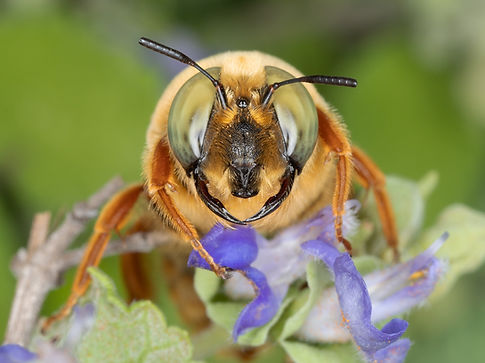
A male Protoxaea gloriosa
Texas mesoxaea
Mesoxaea (Mesoxaea) texana
Family: Andrenidae
Size: 20-24 mm (male)
17-20 (female)
Associated plants:
Silver-leaf Nightshade
(Solanum elaeagnifolium)
Plant family: Solanaceae
Shrubby blue sage
(Salvia ballotiflora)
Plant family: Lamiaceae
Whitebrush
(Aloysia gratissima)
Plant family: Verbenaceae
When and where seen:
May & June 2021
Puerto Rico, TX (Hidalgo Co.)
Roma, TX (Starr Co.)

A male Mesoxaea texana (Texas mesoxea)

Dorsal view of male bee: note the bulbous, fly-like eyes.

Dorsal view of male bee

A female Mesosoaea texana

Face of a female Mesoxaea texana: note the long antennal scapes and long flagellar segment above them (F1). The rest of the antennal segments are relatively short.

Face of female bee
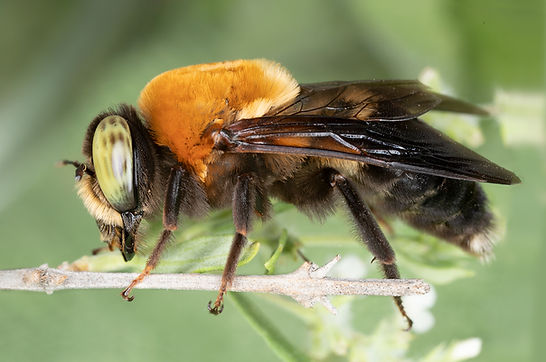
A male Mesoxaea texana
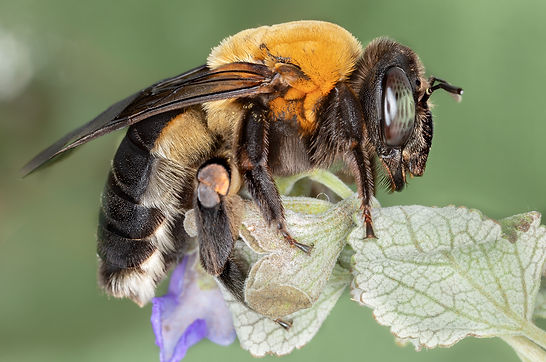
A female Mesoxaea texana
The Texas mesoxaea is a hefty bee with prominent green eyes and dark antennae; a box-like thorax topped with rust-orange hairs; and a dark abdomen with metallic green and purplish tints and covered with dark hairs. Males have long, curved, reddish-black mandibles, used to immobilize females during mating. The faces of both males and females are covered with predominantly dark hairs above the antennae, and pale hairs below the antennae. Male bees’ convergent compound eyes give them a fly-like appearance.
Mesoxaea can be confused with Protoxaea gloriosa in the field, as both are singularly large bees with rust-orange thorax hairs. Mesoxaea can be distinguished from Protoxaea by two traits: (1) there are tufts of white hairs on the tips of the abdomens of Mesoxaea males and females (T5 on females and T6-T7 on males); and (2) the tip of the male Mesoxaea abdomen is notched. Protoxaea lack these traits.
Mesoxaea texana is the only species of its genus in Texas. A handful of other Mesoxaea are found in Mexico (M. arizonica, M. clypeata, M. nigerrima, M. rufescens, M. tachytiformis and M. vagans). Two of these, Mesoxaea arizonica and M. rufescens, sometimes cross the border into Arizona. The male Mesoxaea texana can be distinguished from all others of its genus by the presence of dark hairs covering the area from the bee’s antennal sockets to the hind margin of its head.
A NOTE ON TAXONOMY: In 2015, entomologist M. S. Engel placed Mesoxaea texana in a newly erected subgenus, Heteroxaea. Bees in this subgenus were differentiated by these traits: females had pale hairs on the rear portion of the abdomen; and males had forewings that were glassy toward the base, but dark on the apical (outer) third). These traits are still useful in identifying Mesoxaea texana.
In 2022, a phylogenic study by Bossert et al concluded that Heteroxaea should be abandoned as a subgenus and that Mesoxea texana should be placed in the subgenus Mesoxaea. The Texas mesoxaea nonetheless continues to appear in several popular databases under the subgenus Heteroxaea.
Mesoxaea & Protoxaea Species of the Lower Rio Grande Valley
Glorious protoxaea
Protoxaea gloriosa
Family: Andrenidae
Size: 17-22 mm (male)
13-16 (female)
Associated plants
Silver-leaf Nightshade
(Solanum elaeagnifolium)
Plant family: Solanaceae
Shrubby blue sage
(Salvia ballotiflora)
Plant family: Lamiaceae
Whitebrush
(Aloysia gratissima)
Plant family: Verbenaceae
When and where seen:
May & June 2021
Puerto Rico, TX (Hidalgo Co.)
Roma, TX (Starr Co.)

The male glorious protoxaea is a burly, golden-haired bee with primarily red legs and large green eyes.

The bee's abdomen and head are black, although this trait is obscured under dense golden hair.

Like Mesoxaea males, Protoxaea males have faces that are striking and unusual: they are fly-like, with convergent green compound eyes and low-set ocelli, with the median ocellus close to the clypeus.

Like the male bee, the female glorious protoxaea has a thorax and head largely covered with golden hairs. Its legs are predominantly red.

As is typical of Oxaeinae, Protoxaea gloriosa females have large, conspicuous knee plates on the apical end of each hind femur that join with smaller plates on the tibiae.

The female bee’s dark face is heavily pitted and fringed with golden hairs, its jaws long and curved and its clypeus protuberant.
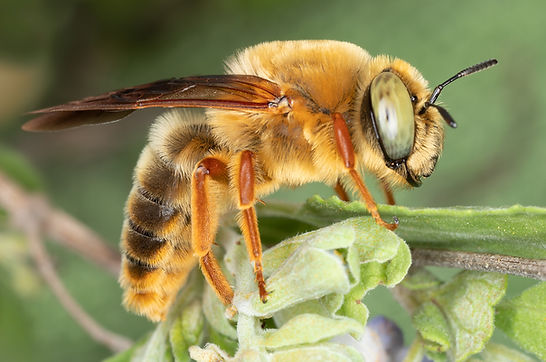
A male Protoxaea gloriosa
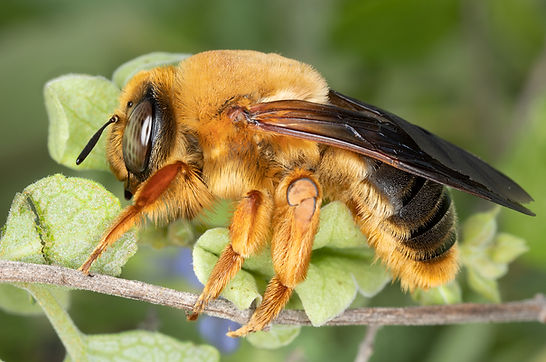
A female Protoxaea gloriosa
Protoxaea gloriosa is a beautiful, large, golden-haired bee with red legs and green eyes. It is the sole member of its genus within the United States. Its size and general appearance make it difficult to confuse with bees of any other genera except Mesoxaea. Differences between this species and Mesoxaea texana are discussed above.
Protoxaea gloriosa is principally a Mexican species: it ranges from the west to the east coast of Mexico, at least as far south as Querétaro. Within the United States, Protoxaea gloriosa is relatively uncommon, although it can be abundant locally.
Protoxaea gloriosa males and females appeared during late May and early June of 2021 in the Tamaulipan thornscrub habitat of a ranch located in Puerto Rico, Texas (Hidalgo Co.) .
CITE THIS PAGE: Sharp, Paula and Ross Eatman. "Mexoxaea and Protoxaea." Wild Bees of the National Butterfly Center of Mission, Texas. 15 Jan. 2019, http://www.wildbeestexas.com. Accessed [day/month/year guide accessed].